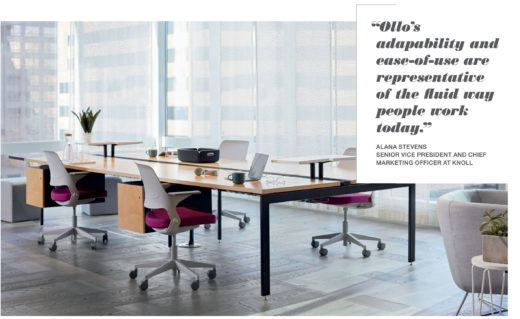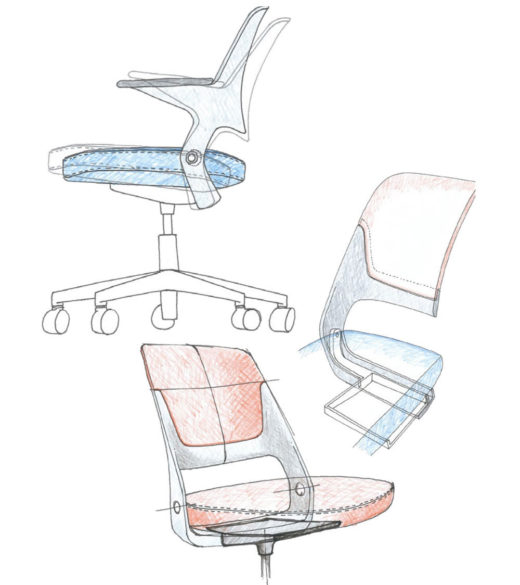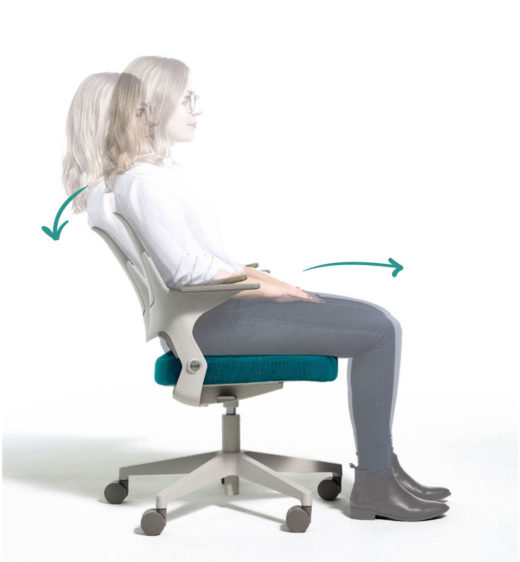Ollo Idea & Concept
Workplace Research
Ollo
Idea and Concept
Today’s workplace is a constant hive of activity with people moving between settings and tasks, sharing chairs back and forth with colleagues, and rolling these chairs in and out of different work configurations.
With that constant movement in mind, Glen Oliver Loew designed Ollo as an everywhere and everybody chair—one that provides comfort in a variety of settings, whether planned or impromptu, and that accommodates an array of postures without the many adjustments typical of a task chair. “In an environment where people change tasks quickly and frequently, the ‘de-featured’ task chair is key to a successful modern work environment,” says Alana Stevens, Senior Vice President and Chief Marketing Officer at Knoll. “Its adaptability and ease-of-use are representative of the fluid way people work today.”
The Need for Variety in Office Seating
As Benjamin Pardo, Knoll’s Executive Vice President and Design Director, points out, Ollo marks the emergence of a new product category for Knoll, the light task chair, which embodies the expanded need for variety in office seating from the personalized and customized to the more communal and intuitive. “Knoll’s office seating is known for being responsive to users’ movements and this chair does it simply, without grand gestures; you just decide how you want to sit and the chair adjusts accordingly,” says Pardo

“A chair never starts with a blank piece of paper,” explains Loew of the ideas and images that drove his design. And he should know. As a professor of product design at the University of Fine Arts in Hamburg, Germany, where he also oversees his own studio, he has borne witness to more than his fair share of design-world origin stories. In the case of Ollo, the trajectory of its development is as much about how Loew sees the job of a designer as it is about the choices he made during the development process of this chair. In an era where the line between a person and their brand is increasingly blurry, Glen Oliver Loew is somewhat of an anomaly.
He sees each new product commission not as an occasion to perpetuate his own name or signature style, but as an opportunity to reassert the identity of the company he is working with. And it is this view of the designer as both interpreter and facilitator that guided the development of Ollo, a chair that looks at once familiar and new, allowing it to blend in to any work setting. Like Loew, Ollo has no need to flaunt itself. Its materials and technical details are quietly innovative—the result of many months of detailed study and discussion with Knoll’s product development team.

Honoring Heritage with Bold Simplicity
Loew’s aversion to asserting his own signature is not a rejection of a designer’s responsibility and prerogative. Quite the opposite: it’s a different understanding of exactly whose authorship should prevail. He maintains that the DNA should come from the company producing the product and not from him. In delving into the “molecules” of Knoll’s DNA, Loew was drawn to Eero Saarinen’s Executive Chair of 1950 and, in particular, the seemingly effortless way the curved upholstered back wraps around the seat, almost cradling it in its arms. The bold simplicity of that relationship between back and seat as independent yet interdependent pieces reappears in Ollo in an updated form responsive to today’s workplace and the more ergonomic expectations of contemporary users.


Instead of the monolithic back of the Saarinen chair, the Ollo back is graphically expressed as a two-part composition of different grades of nylon fused together. The bottom part is more rigid to give lumbar support while the softer upper portion provides comfort and flexibility as you shift positions and lean backward, allowing the effortless transition between upright and reclining postures that is needed by workers who are constantly juggling tasks and moving between independent work and team meetings. The nod to Saarinen situates Ollo within Knoll’s rich history while, to the close observer, the chair’s seamless profile signals Loew’s exacting eye. “From the beginning, I was confident that he could both reference Saarinen and produce a completely contemporary chair,” explains Pardo.
Tucked under the seat is a weight compensated mechanism that makes any adjustment between users or changes in activity unnecessary–the chair has just a single lever to adjust the height of the seat. As you recline, shifting your body backward, the seat balances this motion by sliding forward and up. Unlike the typical task chair mechanism that hangs below the seat, this one is virtually hidden. “It’s a minimalist mechanism,” says Knoll Product Engineer Andrew Hector. “But it was complicated to figure out and it took lots of back and forth between Loew and Knoll to get it to the proper level of refinement,” he adds.
Designing for Today’s Work
All the distinctive and innovative aspects of the chair—its overall agility, responsive movement, and fluid shape—are not achieved through aesthetic flourishes or an array of knobs and handles but are integral to the overall form. As with all Knoll products, it’s a testament to the alignment of concept and execution, design and manufacture and, ultimately, to Loew’s innate understanding of how people work today.
Through research, Knoll explores the connection between workspace design and human behavior, health and performance, and the quality of the user experience. We share and apply what we learn to inform product development and help our customers shape their work environments. To learn more about this topic or other research resources Knoll can provide, click here.